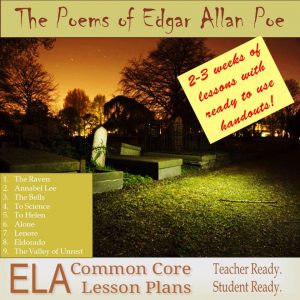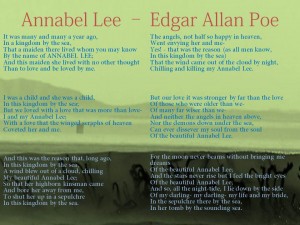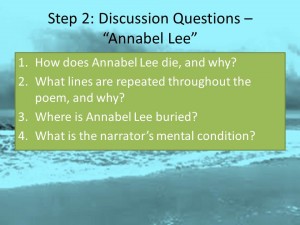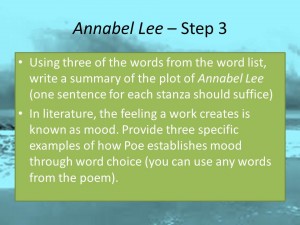For the most wild, yet most homely blog post which I am about to type, I neither expect nor solicit belief. Mad indeed would I be to expect it, in a case where my very senses reject their own evidence. Yet, mad am I not -and very surely do I not dream.
My immediate purpose is to place before the world, plainly, succinctly, and without comment, a series of mere classroom events. In their consequences, these events have delighted-have strengthened me-have made me look good amid my colleagues.
Hereafter, perhaps, some intellect may be found which will reduce my simple “Annabel Lee” lesson plan to the trash bin, but if you’re teaching Edgar Allan Poe poems-“Annabel Lee,” for example-and don’t feel like spending 29 minutes blabbing on about literary devices, pay attention.
Start with vocabulary application.
Step 1. Start with vocabulary?!?!?!?! What about poem annotation? What about poem analysis? What about sound devices in poetry? What about literary terms?
(You see, what I did there was pose a fake question from Mr. Angry Literature Teacher Who Mistakenly Believes His Class is A Repository of All That’s Good About Literature in order to provide links to all those things my semi-fictitious angry teacher questions in his imaginary rant. He’s the guy who refuses to dress up like a corpse when teaching “The Cask of Amontillado,” “The Tell-Tale Heart,” or “The Pit and the Pendulum.”)
Yes, start with vocabulary from “Annabel Lee.” Or more specific, start with this image/slide that I project on the board as students file in from the outer darkness referred to as the hallway.
Step 2. Read the poem, aloud, as a class. If you don’t have copies of “Annabel Lee,” here it is. Even if you do have copies of “Annabel Lee,” here it is.
Intermission. Since you’re already used to the format of a simple instruction followed by an image, I’m going to take advantage of it.

‘);
Step 3. Write a summary of “Annabel Lee” using words from the list. Write about how word choice affects the poem’s mood.
Step 4. Read another poem by Edgar Allan Poe. Write a 5-6 sentence summary of that poem using 3 of the vocabulary words from the list. Here’s a list of poems by Edgar Allan Poe.
Let’s take a look at standards covered by this Edgar Allan Poe poetry lesson plan.
- L.9-10.4 Determine or clarify the meaning of unknown and multiple-meaning words and phrases based on grades 9-10 reading and content, choosing flexibly from a range of strategies. Use context (e.g., the overall meaning of a sentence, paragraph, or text; a word’s position or function in a sentence) as a clue to the meaning of a word or phrase.
- L.9-10.5 Demonstrate understanding of figurative language, word relationships, and nuances in word meanings.
- L.9-10.5b Analyze nuances in the meaning of words with similar denotations.
- RL.9-10.4 Determine the meaning of words and phrases as they are used in the text, including figurative and connotative meanings; analyze the cumulative impact of specific word choices on meaning and tone (e.g., how the language evokes a sense of time and place; how it sets a formal or informal tone).
Share This:




Speak Your Mind